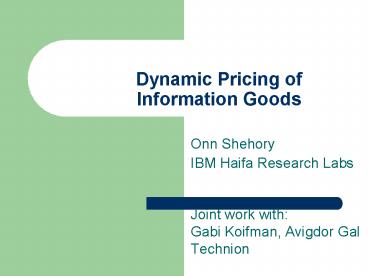Dynamic Pricing of Information Goods - PowerPoint PPT Presentation
1 / 25
Title:
Dynamic Pricing of Information Goods
Description:
Posted pricing DF,TA. Price discrimination PP,MBPP. Negotiation based pricing PP,MBPP ... (Varian) price discrimination: an issue when willingness to pay ... – PowerPoint PPT presentation
Number of Views:29
Avg rating:3.0/5.0
Title: Dynamic Pricing of Information Goods
1
Dynamic Pricing of Information Goods
Onn Shehory IBM Haifa Research Labs
- Joint work with
- Gabi Koifman, Avigdor Gal
- Technion
2
Motivation
- Rapid growth in electronic commerce
- The information economy vision (Kephart et al.)
- Agents accumulate knowledge, stored in databases
- Agents can benefit from trading database tuples
- No mechanism for such trade
3
Problem Statement
- A mechanism for negotiating database-based
information goods requires - Correctly matching of attributes of database
goods - Pricing of (DB-based) information goods
Bobs Agent
Alices Agent
I need more information NOW. Willing to spend 50
for it.
I can sell records to make profit
DomainStocks
DomainStocks
4
(DB-based) Information goods market vs.
traditional market
- Negligible marginal cost
- Uniqueness
- Pricing
- Experience goods (Advertising)
- Delivery
- Schema/tuple ambiguity
5
Compatibility Evaluation
- DB information goods compatibility evaluation can
be reduced to the schema mapping problem - A mapping F from S to S is a set of S pairs
(a, a), a? S, a? S? null and SF (S) - µatt(a,a) is the similarity measure of a, a
- µF is computed based on all µatt in F
- Utility is based on µF
6
Buyers Anxiousness Level
- Assumption willingness to pay is proportional to
buyers anxiousness - A seller can perform price discrimination across
consumers with different anxiousness level - Why should a buyer expose its true anxiousness
level? - When discriminating based on TTD (Time To
Deliver), learning anxiousness is enabled - (we use Bayesian learning)
7
Market Trends
Calc current supply\demand levels
Calc average supply
Re-calc average supply
Calc average personal demand
Re-calc average personal demand
set reference supply\demand levels
Re-set reference supply\demand levels
8
Utility Evaluation
- Distance(seller, buyer) number of tuples that
exist in the sellers database and not in the
buyers database - If (distance (seller, buyer)gt ?) then
- proceed with negotiation
- Computing Distance() is problematic
- Database comparison, or
- Zero-knowledge mechanism
- Relief can approximate via statistical measures
9
Pricing Policies
- Derivative-Follower (DF)
- Trial and Error (TA)
- Personalized Pricing (PP)
- Market Based Personal Pricing (MBPP)
- Posted pricing DF,TA
- Price discrimination PP,MBPP
- Negotiation based pricing PP,MBPP
10
Negotiation Participants
- DB Exchange agent
- Trusted third party
- Receives ads, publishes to subscribers
- Players buyers and sellers
- Initial database
- Buyer maximize (number of distinct tuples),s.t
min(cost) - Seller maximize (profit)
11
Agent 1
Agent 2
DBE
Negotiation Model
Interaction diagram
12
Simulation System
- Java language JMS on J2EE.
- MS-access database
- JMS messaging
13
Simulation Participants
- Buyers
- Anxiousness level
- Max budget for transaction
- Distance threshold (0)
- Sellers
- Current price list
- Probabilities for anxiousness level distribution
- Assumed supply
- Assumed demand
14
Pricing Policies Evaluation
- System profit /volume
- Equilibrium
- Market settings
- Non-competitive market
- Competitive market
15
System Profit
Market Based Pricing
Derivative follower
Trial and Error
Personalized Pricing
Market Based Pricing
Derivative follower
Trial and Error
Personalized Pricing
16
Equilibrium
PP agent should deviate to MBPP
MBPP agent should not deviate
17
Conclusions
- We provide mechanism for trading databased-based
information goods - Pricing policies that allow negotiation and
personalization, perform better than (known in
the art) posted pricing - Market based personalized pricing policy performs
better than personalized pricing, in terms of
stability
18
The End
19
Backup Slides
20
Related Work
- Pricing Information Goods
- (Varian) price discrimination an issue when
willingness to pay varies across consumers. Need
to - Determine the consumer's willingness to pay
- Prevent black market
- Information Economy and Software Agents
- (Kephart et al.) The vision
- Agent faster, but less intelligent and flexible
- Effects on Global Economy
- Multiagent Negotiation
- Protocol, objects, reasoning model (Jennings et
al.) - Multiagent Learning
- Bayesian learning in negotiation Zeng and Sycara
21
Future Work
- Support buyers that wish to build a database from
an initial empty tuples set. - Situations for compatibility that also use
auxiliary information. - Suggest techniques that allow a fully automated
algorithm. - Additional pricing policies.
- Suggest a secure algorithm for distance(a,b),
with no use of third trusted party. - Allow the buyer to choose a bidding policy that
maximizes its utility under specific market
settings.
22
Database-based Information Goods Compatibility
Evaluation
Evaluation Methodology and Results
- Imprecision
- Mapping Effectiveness
- Mapping Cost
23
Compatibility Evaluation (1) Mapping Imprecision
Evaluation Methodology and Results
Using SafeSigns ability to generate 0-imprecision
mappings was doubled!!!
Not Improved 29.8
Not Improved 13.7
Improved 40.2
No Change (0 imprecision) 21.2
Improved 50.8
No Change (0 imprecision) 21.4
No change 8.5
No change 14.2
24
Compatibility Evaluation (2) Mapping
Effectiveness
Evaluation Methodology and Results
25
Compatibility Evaluation (3) Mapping Cost
Evaluation Methodology and Results































